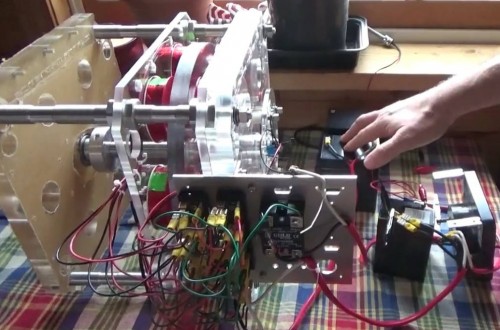Experiments With The Quanta Q3 Pulse Motor & How A Pulse Motor Works
Now that the Quanta Magnetics Q3 Charge Accelerator pulse motor section is finished and running I am performing various experiments with it for a while before moving on to building the energizer/generator section.
The Quanta Magnetics Q3 Charge Accelerator is a three part machine with a pulse motor, a generator and a toroid coil section. The pulse motor drives the rotor around and gives a little bit of mechanical energy which will later be used to turn the generator and toroid sections.
The pulse motor section is not just a motor though. This is a super efficient motor and it can also charge batteries at the same time as it is driving the rotor.
Here is how it works.
There is a timing disk on one end of the Q3 pulse motor section. This has six magnets on it. There are also two extra magnets that you can use to change the timing. A magnetic reed switch is used to slide closer or farther away from the magnets to adjust the timing. You can also turn the outside wheel which holds the reed switch to adjust the motor timing.
You can adjust the motor timing to pulse six times per revolution of the motor. Or you can use the adjusting magnets and set it to one or two pulses per rotation. This gives you a lot of play room for experimentation.
 Experimenting with the Quanta Magnetics Q3 pulse motor
Experimenting with the Quanta Magnetics Q3 pulse motor
But thats not all....
You can also remove some of the coils from the pulse motor section so that they are not pulsed at all. This gives you even more flexibility. You can have all 12 coils pulsing together, only 6 coils or any other combination down to one single coil. This gives you a lot of options to experiment with this device.
Now as the rotor turns, a magnet passes the reed switch, triggering it. This activates a solid state relay and pulses the drive battery to the drive coils. Here is where a pulse motor is so much different from a normal motor.
In a normal motor the power is applied to the device at all times. The power cycles through the different coils as the motor turns.
In a pulse motor the power is only applied for a very tiny amount of time. This is the pulse. The pulse drives the rotor around.
Now here is another big difference in the pulse motor. The collapsing field in the coils after the pulse is removed (back EMF) is now collected and sent to a battery to be charged. Now instead of wasting the back EMF as in a normal motor, we are saving it and sending it to a battery to be charged. With the proper timing this energy can be fed back into the run battery, saving energy and extending the run time on that battery.
With the design of the Q3 Charge Accelerator there are 6 high power Neo magnets rotating between 12 coils of the pulse motor. As a magnet passes a coil, you get a pulse of energy in the coil. This is the second charge which is sent to the battery to be charged.
So you essentially get two pulses of charge on the battery for each pulse of energy used to turn the rotor. Its a two for one deal.
Some people rant and rave and say this is not possible. Well, sure it is. We are just collecting the energy which is normally wasted in a standard motor. And there is a bonus of the magnets generating a charge in the coils as they pass. No laws of physics are being violated.
The key though is to tune the pulse motor and experiment with it until I get the maximum output charge with the least amount of current used from the run battery. My goal is to charge up and desulfate lead acid battery banks, such as the one powering the off grid tiny house on wheels, in a faster manner.
I think that this goal is possible with time and experimentation.
You can watch today's video here: Experimenting With The Quanta Q3 Pulse Motor Section
While you are over there please subscribe to my YouTube channel and follow our daily videos as we strive to become self sufficient and off the grid on a budget.
About the Author
| Troy Reid |



